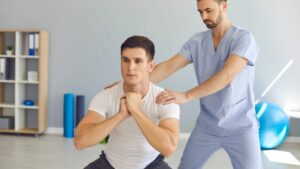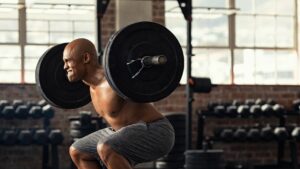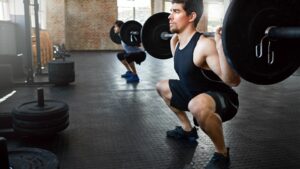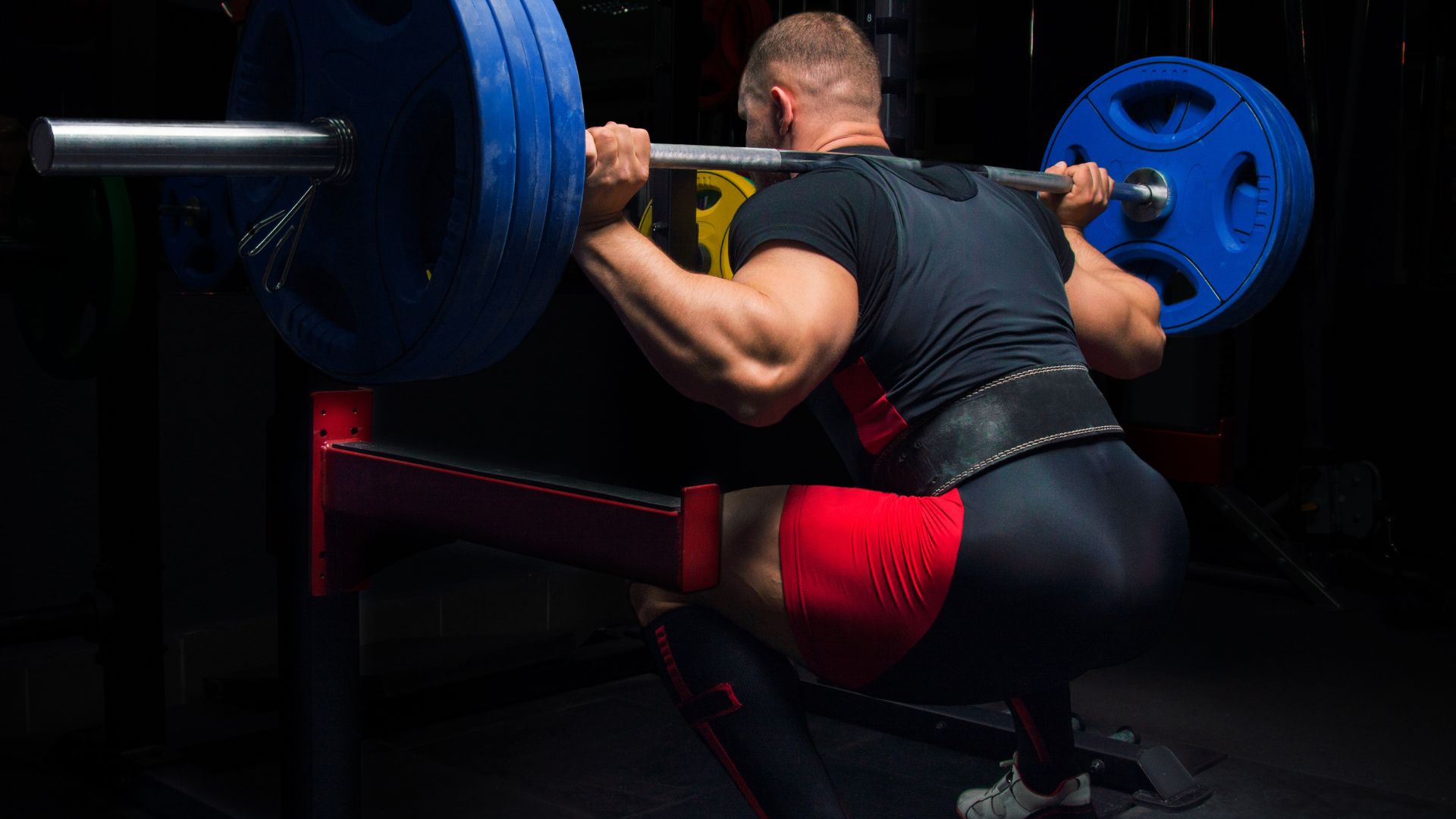Have you ever felt your muscles quiver while performing squats? That involuntary shaking might seem perplexing, but it’s a common occurrence with several underlying factors.
In this blog post, we’ll delve into the science behind the shaking phenomenon during squats. From muscle engagement and fatigue to neuromuscular activation, stabilization challenges, and the impact of form and muscle imbalances we’ll unravel the interconnected reasons behind those tremors.
By understanding these dynamics, you’ll gain insights into optimizing your squat technique, minimizing shaking, and ensuring effective and safe workouts
Shaking indicates muscle engagement during squats: is this true?
Shaking during squats can indicate muscle engagement, especially when performing challenging or heavy lifts. Shaking usually occurs because the muscles involved are working hard to stabilize and support the weight, maintain proper form, and execute the movement.
When you perform squats, you primarily engage muscles in your legs, core, and lower back. The shaking is often a sign that these muscles are being recruited to maintain balance and stability. It can be particularly noticeable during heavy lifts or when you’re pushing your limits.
Let me explain in more detail why shaking can occur during squats: Muscle Engagement, Fatigue, Neuromuscular Activation, Stabilization, Form and Technique, and Muscle Imbalances.
Remember that some degree of shaking can be normal, especially when pushing yourself during challenging workouts. However, excessive or uncontrollable shaking could indicate issues with form, technique, or even underlying medical conditions.
It’s always a good idea to start with lighter weights and focus on proper form before gradually increasing the load. If you’re uncertain about your technique or experience persistent shaking, consider consulting a fitness professional or a healthcare provider for personalized guidance.

Please allow me to delve deeper into this here.
Muscle Engagement.
Shaking during squats is often a result of intense muscle engagement. As you lift the weight, your muscles are contracting to control the movement and stabilize your body. Shaking indicates that the muscles are working hard to maintain your position and balance. explain
Let’s break down the process of muscle engagement and how it relates to the shaking you might experience during squats:
Muscle Contraction:
When you perform squats, your muscles need to contract (shorten) to move your body and the weight you’re lifting.
The main muscles involved in squats include the quadriceps (front thigh muscles), hamstrings (back thigh muscles), glutes (butt muscles), and core muscles.
Stabilization:
Squats are a compound movement, meaning they involve multiple muscle groups working together to execute the exercise.
In addition to the muscles directly responsible for moving your body up and down, other muscles are engaged to stabilize your posture.
These stabilization muscles include the erector spinae (muscles along your spine), transverse abdominis (deep core muscle), and muscles around the hips and pelvis.
Control and Balance:
As you lower your body into a squat position, your muscles need to work in harmony to control the movement and maintain balance.
This involves a complex interplay of muscle contractions and relaxations to keep your body steady.
Intensity and Effort:
When you increase the weight you’re lifting or perform more repetitions, the intensity of the exercise rises.
Your body responds by recruiting more muscle fibers to cope with the added demand. These additional muscle fibers might not be accustomed to such intense activation, leading to the sensation of shaking as they engage.
Neuromuscular Adaptation:
Your nervous system plays a crucial role in muscle activation.
When you’re lifting heavier weights or challenging your muscles in new ways, your nervous system learns to coordinate the muscle contractions more effectively.
Shaking can occur when your nervous system is adapting to this increased demand and coordination.
Fatigue:
As you continue to perform squats, your muscles can become fatigued due to the repeated contractions and work they’re doing. Fatigue can cause slight tremors in the muscles, leading to shaking.
Overall, the shaking you experience during squats is a combination of these factors. It’s a natural response of your body as it works to stabilize itself, control the movement, and adapt to the demands you’re placing on it.
However, it’s essential to distinguish between normal muscle engagement-induced shaking and excessive shaking that might result from poor form or technique. If you’re unsure about your form or experience significant shaking that hinders your performance, consider seeking guidance from a fitness professional to ensure safe and effective squatting technique.
Fatigue
Shaking can also occur when your muscles are fatigued. As you continue performing repetitions, your muscles might start to tire, leading to slight trembling.
This can be more noticeable when lifting heavy weights or performing a high number of repetitions.
Let’s delve deeper into how muscle fatigue contributes to the shaking phenomenon:
Energy Depletion:
During physical activity like squats, your muscles require energy in the form of ATP (adenosine triphosphate) to contract.
As you perform repetitions, especially with heavier weights, your muscles utilize ATP and other energy sources.
As these energy reserves become depleted, muscle contractions might become less smooth and more erratic, leading to trembling or shaking.
Lactic Acid Buildup:
During intense exercise, especially resistance training like squats, your muscles generate lactic acid as a byproduct of energy production.
Lactic acid can accumulate in the muscles and contribute to a sensation of fatigue. This buildup can impact muscle function and lead to shaking, especially as you push your limits.
Neuromuscular Fatigue:
The communication between your nervous system and muscles can also be affected by fatigue.
As your muscles get tired, the signals from your brain to your muscles might not be as precise. This can result in uneven muscle contractions and contribute to shaking.
Muscle Fiber Recruitment:
When you lift heavy weights or perform a high number of repetitions, your body recruits a larger number of muscle fibers to cope with the demand.
This recruitment might include muscle fibers that aren’t as accustomed to such intense activity. These “less experienced” muscle fibers might contribute to shaking as they struggle to maintain their function.
Form Breakdown:
As fatigue sets in, it’s common for your form and technique to deteriorate.
When your form is compromised, certain muscles might work harder than others to compensate, leading to imbalances and shaking.
Proper form helps distribute the load more evenly among muscle groups, reducing the likelihood of excessive shaking.
Recovery and Adaptation:
Muscle shaking due to fatigue can also be part of the process of muscle recovery and adaptation.
The micro-tears in muscle fibers that occur during exercise trigger a repair and growth process. The shaking might be a sign that your muscles are working to repair and adapt to the stress you’ve placed on them.
Remember that some degree of shaking is normal, especially during intense workouts. However, if shaking is severe, uncontrollable, or accompanied by pain, it’s essential to assess your form and technique.
Gradually increasing the intensity and weight of your workouts, allowing adequate rest between sessions, and maintaining good nutrition and hydration can all help manage muscle fatigue and reduce excessive shaking.
Neuromuscular Activation.
When you’re lifting challenging weights, your body recruits more muscle fibers to handle the load.

This can lead to involuntary shaking as your nervous system works to coordinate the activation of these additional muscle fibers.
Let’s delve deeper into what neuromuscular activation is and how it relates to the involuntary shaking you might experience during challenging lifts like squats:
Neuromuscular System:
The neuromuscular system refers to the intricate connection between your nervous system (brain, spinal cord, and nerves) and your muscles.
This connection allows your brain to send signals to your muscles, telling them when and how to contract.
Muscle Fiber Recruitment:
When you perform an exercise like squats with challenging weights, your body needs to generate more force to lift the load.
To achieve this, your nervous system recruits a larger number of muscle fibers within the muscle groups you’re targeting.
These muscle fibers are often organized in a hierarchy, with smaller, less powerful fibers being recruited first and larger, more powerful fibers being activated as the load increases.
Coordination and Synchronization:
As your nervous system recruits additional muscle fibers, it must also coordinate their contractions to work together seamlessly.
This coordination is crucial for generating the required force and maintaining proper form during the movement.
Involuntary Shaking:
In situations where your body is not accustomed to the intensity or type of demand being placed on it, this coordination process can sometimes lead to involuntary shaking.
The nervous system is rapidly trying to adapt to the increased recruitment of muscle fibers and their coordination, which can result in small tremors or shakes.
Learning and Adaptation:
Over time, with consistent training, your nervous system becomes more efficient at coordinating muscle contractions and handling challenging weights.
As your neuromuscular system adapts, the shaking tends to decrease, and your movements become smoother and more controlled.
Skill Development:
This process is similar to learning a new skill. When you first start, there might be some clumsiness or unsteadiness as your brain and muscles figure out the most effective way to work together.
With practice, your neuromuscular system becomes more adept at handling the task.
It’s important to note that some degree of shaking during neuromuscular activation is normal, especially when pushing your limits. However, excessive shaking that compromises your form could increase the risk of injury.
Gradually progressing in weight and intensity, practicing good form, and allowing your body time to adapt can all contribute to minimizing shaking as you continue your fitness journey.
Stabilization.
Squats require not only leg strength but also core and back stability. The shaking might come from your body’s efforts to maintain a stable posture throughout the movement.
Let’s dive into how stabilization is connected to shaking during squats and why it’s so important:
Stabilization Muscles:
Squats are a compound movement that engages multiple muscle groups, including the legs, core, and lower back.
While the leg muscles provide the primary force to lift the weight, the core and lower back muscles play a critical role in stabilizing your spine and maintaining proper posture throughout the movement.
Core Involvement:
The core muscles, including the rectus abdominis, obliques, and transverse abdominis, work together to stabilize your spine and prevent excessive movement or arching.
The core acts as a natural weight belt, helping to protect your lower back and maintain a neutral spine position during the squat.
Back Stability:
Similarly, the muscles of the lower back, such as the erector spinae, also contribute to maintaining proper spinal alignment.
They help prevent rounding or excessive curving of the spine, which can be detrimental to your form and potentially lead to injuries.
Shaking and Stabilization:
When you perform squats, especially with challenging weights, your body relies heavily on these stabilization muscles to support the load and maintain correct posture.
The shaking you might experience can be attributed to the effort these muscles are putting in to stabilize your spine and prevent any unwanted movement.
Adaptation and Improvement:
Over time, with consistent training, your stabilization muscles become stronger and more adept at their role.
As these muscles become better at stabilizing your spine and maintaining proper alignment, the shaking tends to decrease.
Form and Injury Prevention:
The shaking is a signal that your body is working to maintain proper form. If your stabilization muscles are not engaged effectively, it could lead to compromised form, which might increase the risk of injury.
Ensuring that your core and lower back muscles are engaged and working in harmony with your leg muscles is crucial for both performance and safety.
To minimize shaking and improve stabilization during squats:
Focus on engaging your core muscles before and during the squat.
Maintain a neutral spine position throughout the movement.
Gradually increase weights to allow your stabilization muscles to adapt.
Consider incorporating specific core and lower back strengthening exercises into your routine.
By prioritizing proper form, engaging your stabilization muscles, and progressively challenging your body, you can work towards reducing shaking and performing squats more effectively and safely.
Form and Technique.
Shaking can also be a sign of improper form or technique. If you’re not maintaining the correct posture or alignment, your body might shake as it tries to adjust and stabilize itself. This is why it’s crucial to learn and practice proper squat form.
Let’s delve deeper into how improper form can contribute to shaking and why proper squat form is essential:

Correct Alignment:
Proper squat form involves maintaining the correct alignment of your body throughout the movement.
This includes maintaining a neutral spine, proper hip and knee alignment, and balanced weight distribution between your feet.
Muscle Activation:
When you perform squats with incorrect form, certain muscles might be overworking while others are underworking. This imbalance can lead to instability and shaking as your body tries to compensate for the misalignment.
Uneven Pressure:
If you’re leaning too far forward, rounding your back, or shifting your weight excessively to one side, it can lead to uneven pressure on your muscles and joints. Your body might shake as it tries to find a stable position.
Joint Stress:
Incorrect form can place additional stress on joints, such as the knees and lower back, which can lead to discomfort and instability. Shaking might occur as your body tries to navigate this added stress.
Neuromuscular Adaptation:
When your body is not used to a particular movement pattern due to incorrect form, your neuromuscular system might struggle to coordinate the muscle contractions effectively. This can lead to shaking and lack of control.
Learning Proper Form:
Learning and practicing proper squat form is essential for reducing shaking and ensuring the safety and effectiveness of the exercise.
When you use correct form, your muscles work in harmony, and your body can efficiently generate force without unnecessary stress on joints.
To practice proper squat form:
Foot Placement:
Keep your feet shoulder-width apart or slightly wider. Point your toes slightly outward.
Spine Alignment:
Maintain a neutral spine from your head to your tailbone. Avoid rounding or arching your back.
Hip and Knee Alignment:
Bend your hips and knees simultaneously, ensuring your knees track over your toes without caving in or going too far forward.
Depth:
Lower your body until your thighs are at least parallel to the ground, while keeping your heels on the ground.
Breathing:
Inhale as you lower and exhale as you push up, engaging your core muscles for stability.
Practicing squats with proper form, gradually increasing the weight, and seeking guidance from a fitness professional can help you develop the right technique and minimize shaking.
Remember that it’s okay to start with lighter weights to ensure you’re performing the exercise correctly before adding more resistance.
Muscle Imbalances.
If you have muscle imbalances or weaknesses in certain areas, your body might shake as it struggles to evenly distribute the load. Working on strengthening these areas can help reduce shaking over time.
Let’s explore this topic further:
Muscle Imbalances:
Muscle imbalances occur when certain muscles are stronger or more developed than others.
This can lead to uneven distribution of force during exercises like squats, which require multiple muscle groups to work together.
Compensation:
When you have muscle imbalances, your body might naturally compensate by relying more on the stronger muscles and less on the weaker ones.
This can result in an uneven and potentially unstable movement pattern, leading to shaking as your body tries to manage the load.
Stability Issues:
Muscle imbalances can affect your ability to stabilize your body during squats.
Weaker muscles might struggle to provide the necessary support, causing shaking as your body attempts to maintain balance and control.
Common Imbalances:
Some common muscle imbalances that can affect squatting include weak glutes, weak core muscles, and tight hip flexors.
These imbalances can alter your biomechanics and lead to suboptimal squat form.
Addressing Imbalances:
Working on strengthening the weaker muscle groups through targeted exercises can help reduce shaking over time.
Strengthening your glutes, core, and other stabilizing muscles can improve your ability to distribute the load evenly and maintain proper form.
Balanced Training:
Incorporate a variety of exercises that target different muscle groups to prevent and address imbalances.
This includes not only squats but also exercises that focus on core stability, hip mobility, and overall muscular balance.
To address muscle imbalances and reduce shaking during squats:
Incorporate Strengthening Exercises:
Include exercises that specifically target weaker muscle groups. For example, glute bridges, hip thrusts, planks, and lunges can help strengthen the muscles necessary for stabilizing during squats.
Dynamic Warm-Up:
Prior to squats, perform a dynamic warm-up that includes mobility exercises to improve range of motion and activation of key muscle groups.
Progressive Overload:
Gradually increase the weight and intensity of your workouts while focusing on maintaining proper form. This helps the weaker muscles adapt and become stronger over time.
Consult a Professional:
If you’re unsure about your muscle imbalances or how to address them effectively, consider seeking guidance from a fitness professional or physical therapist. They can provide personalized recommendations based on your specific needs.
By addressing muscle imbalances and working on overall muscular strength and balance, you can improve your squat performance, reduce shaking, and minimize the risk of injuries.
Tabular on this topic here.
Here’s a tabular overview of the factors contributing to shaking during squats, along with their explanations and suggestions for addressing each factor:
| Factor | Explanation | Suggestions |
|---|---|---|
| Muscle Engagement | Shaking occurs due to intense muscle contractions for stability and movement. | Gradually increase weights, focus on proper form, and allow muscles to adapt. |
| Fatigue | As muscles tire, trembling can result from depleted energy and lactic acid buildup. | Rest between sets, ensure proper nutrition and hydration, and manage workout intensity. |
| Neuromuscular Activation | Lifting heavy weights recruits more muscle fibers, leading to involuntary shaking. | Practice consistent training to improve neuromuscular coordination and adaptation. |
| Stabilization | Squats require leg, core, and back stability; shaking can result from stabilization efforts. | Engage core muscles, maintain neutral spine, and practice balanced weight distribution. |
| Form and Technique | Shaking can indicate improper form or technique, disrupting muscle coordination. | Learn and practice proper squat form, focus on alignment, and seek professional guidance. |
| Muscle Imbalances | Uneven muscle strength leads to shaking as the body struggles to distribute the load. | Target weaker muscles with specific exercises, work on balanced training, and progress gradually. |
Remember, while this table provides a concise summary, each factor is interconnected, and it’s crucial to consider them as a whole when addressing shaking during squats. Focus on maintaining proper form, gradually increasing weights, addressing muscle imbalances, and allowing your body time to adapt. If you have any doubts or concerns, consulting a fitness professional can provide personalized guidance tailored to your needs.
Conclusion.
Shaking during squats is a multifaceted phenomenon influenced by factors such as intense muscle engagement, fatigue, neuromuscular activation, stabilization, form and technique, and muscle imbalances.
While some degree of shaking is normal, excessive shaking might indicate areas for improvement.
By prioritizing proper form, gradually increasing weights, targeting muscle imbalances, and seeking guidance when needed, you can enhance your squat performance, reduce shaking, and promote overall safety and effectiveness in your workouts.

Hey there, it’s Mike Rrsq, the Editor-in-Chief over at Jsquat.com, and I’m absolutely obsessed with all things squat fitness! I’ve been lucky enough to get some serious recognition for my work in this field. With a solid background in the fitness and wellness industry, I’ve been there right from the get-go, helping shape this website into what it is today.
You see, I’m not just the boss around here; I’m also a passionate contributor. I love sharing my insights through my articles, and trust me, they’re not your run-of-the-mill stuff. Each piece I write is a labor of love, filled with my expertise and real-world experience in the fitness universe. So, if you’re into fitness and looking for some inspiration, you’re in the right place!

